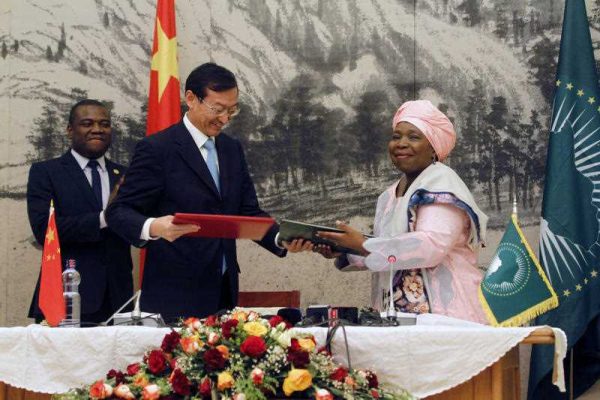The path of China’s trade and investment ties with Africa offers insights into China’s ongoing economic reforms and internationalisation.
China is Africa’s largest trading partner. Bilateral trade is expected to surpass US$200 billion in 2014. Trade with Africa is small in terms of China’s total trade, but it is strategically important because of its composition. Commodities — especially oil — dominate China’s imports from Africa. For Africa, China’s low-cost manufacturers have helped to stimulate consumer markets. These are also reported to have selectively threatened domestic industries, such as textiles.
China’s foreign direct investment (FDI) in Africa is also growing. According to China, in 2012 its FDI in Africa reached US$2.52 billion, reflecting annual growth of some 20 per cent since 2009. Facing a shrinking labour supply, excessive industrial capacity, and a state-led push to upgrade and internationalise the national economic model, in Africa Chinese firms can gain an international foothold and outsource labour-intensive manufacturing. In 2013, China’s state media announced a plan to invest a further US$1 trillion in the continent within a decade.
Infrastructure development is directly and indirectly fundamental to those plans. Visiting Africa in May 2014, Chinese Premier Li Keqiang spoke of connecting African capitals using China’s high-speed rail technology. In November 2014 China Railway Construction Corp signed China’s largest-ever overseas investment deal, agreeing to build a 1400 kilometre railway along the coast of Nigeria, Africa’s largest economy. A five-nation train line in East Africa will in sections replace British narrow rail gauge for China’s standard rail gauge.
Following the footsteps of Li, China’s Foreign Minister Wang Yi recently reiterated China’s commitment to assist Africa to develop ‘Three Major Networks’ — railway, road and regional aviation. Vice-Minister of Foreign Affairs, Zhang Ming, was also in Ethiopia for the 2015 heads of state meeting of the 54-member African Union (AU). The resulting African Union–China deal has been billed as ‘the most substantive project the AU has ever signed with a partner’. It promises to connect the continent by road, rail and air transportation. This year’s triennial leaders’ gathering of the Forum on China and Africa Cooperation is sure to include similar announcements.
China is also investing in steel and iron ore in Africa — pushed by excess capacity in its steel sector at home and pulled by prospective industrialisation in Africa. In late 2014, Hebei Iron & Steel, China’s largest steelmaker, announced plans to shift five million tonnes of production (roughly 11 per cent of its annual output) to South Africa. In 2014 China was also party to a US$20 billion deal reached between Rio Tinto, Chinalco, the International Finance Corporation and the Government of Guinea. The deal will develop Guinea’s Simandou iron ore deposits. It is the largest combined iron ore and infrastructure deal ever attempted in Africa.
Ethiopia is a case of China merging infrastructural FDI with the parallel development of light manufacturing. China’s Huajian Group plans to invest US$2 billion over the next decade to create a shoe-manufacturing cluster that exports to other African nations, Europe and North America. The plan makes use of Ethiopia’s trade preferences with each of those markets and the relatively lower wages of Ethiopian factory workers compared to their Chinese counterparts. In September 2014 the Ethiopian Roads Authority also signed an agreement with China’s CGC Overseas Construction Group to upgrade the Dire Dawa–Dewele highway, which provides a link to the Port of Djibouti.
But this rising economic dependence is not free of contention. Much of China’s FDI in Africa is sovereign loan-financed, contracts are often opaque and there are tensions around the use of imported Chinese labour in building infrastructure. In addition, civil society and more established multinationals in Africa protest Chinese firms’ labour and environmental standards. The Governor of Nigeria’s Central Bank, Sanusi Lamido, said in 2014 that Africa should ‘recognise that China … is in Africa not for African interests but its own’. He called for African governments to take a more competitive stance by adopting policies that allow China to make money while helping to develop the continent. New research, however, suggests those policies remain a cross-continental ‘noodle bowl’.
In the face of a shrinking labour supply, sluggish growth, and excess industrial capacity and savings, China is pushing to upgrade its own economic structure and to increase outbound investment. Prominently, China has promised to massively increase its trade and investment ties with Africa. Understanding these trends and their domestic drivers offers insight into the direction and speed of China’s economic reforms and these particular pathways of China’s own economic internationalisation. This can also better inform Sino–African policy-making.
Lauren Johnston is a Research Fellow in the Melbourne Institute of Applied Economic and Social Research, Faculty of Business and Economics, University of Melbourne.


As reported by VENTURES AFRICA The Hermes-Sojitz international investment foundation, an alliance of Japanese and Europeans investors, believes the retail sector is one of the fastest growing economy in Africa. A rising demand for consumer goods, fuelled by an increase in personal income and a beaming middle class, is considered the main driver of this growth. Several companies around the world have already started competing for the continent’s big consumer goods market. But despite Europe’s and the US’s renewed faith in Africa, Asia remains ahead of its peers. (http://www.ventures-africa.com/2015/02/is-africa-the-new-retail-haven/)
Indeed Alex. China’s low-cost consumer goods and market foresight appear to have given its firms a jump-start in Africa’s fast-growing retail market:
“In the next few decades, Africa’s unique demographic profile and growing discretionary income will make it the investment destination of choice for global companies looking to profit from a young, upwardly mobile consumer.”
http://mgafrica.com/article/2015-01-30-africa-to-the-rescue-why-the-world-needs-africa-to-keep-rising